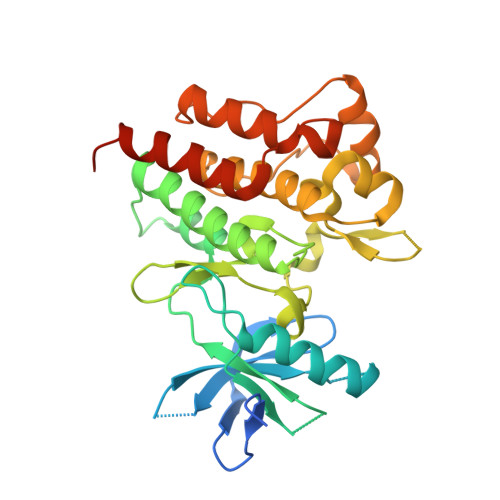c-Met inhibitors with novel binding mode show activity against several hereditary papillary renal cell carcinoma-related mutations.
Bellon, S.F., Kaplan-Lefko, P., Yang, Y., Zhang, Y., Moriguchi, J., Rex, K., Johnson, C.W., Rose, P.E., Long, A.M., O'Connor, A.B., Gu, Y., Coxon, A., Kim, T.S., Tasker, A., Burgess, T.L., Dussault, I.(2008) J Biological Chem 283: 2675-2683
- PubMed: 18055465
- DOI: https://doi.org/10.1074/jbc.M705774200
- Primary Citation of Related Structures:
2RFN, 2RFS - PubMed Abstract:
c-Met is a receptor tyrosine kinase often deregulated in human cancers, thus making it an attractive drug target. One mechanism by which c-Met deregulation leads to cancer is through gain-of-function mutations. Therefore, small molecules capable of targeting these mutations could offer therapeutic benefits for affected patients. SU11274 was recently described and reported to inhibit the activity of the wild-type and some mutant forms of c-Met, whereas other mutants are resistant to inhibition. We identified a novel series of c-Met small molecule inhibitors that are active against multiple mutants previously identified in hereditary papillary renal cell carcinoma patients. AM7 is active against wild-type c-Met as well as several mutants, inhibits c-Met-mediated signaling in MKN-45 and U-87 MG cells, and inhibits tumor growth in these two models grown as xenografts. The crystal structures of AM7 and SU11274 bound to unphosphorylated c-Met have been determined. The AM7 structure reveals a novel binding mode compared with other published c-Met inhibitors and SU11274. The molecule binds the kinase linker and then extends into a new hydrophobic binding site. This binding site is created by a significant movement of the C-helix and so represents an inactive conformation of the c-Met kinase. Thus, our results demonstrate that it is possible to identify and design inhibitors that will likely be active against mutants found in different cancers.
- Department of Molecular Structure, Amgen Inc., Thousand Oaks, CA 91320, USA.
Organizational Affiliation:

















